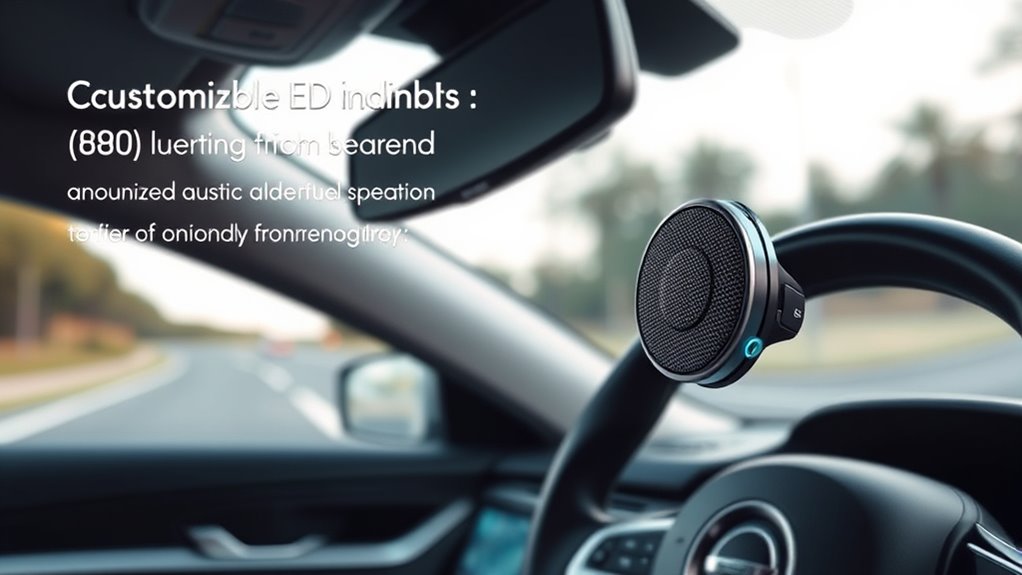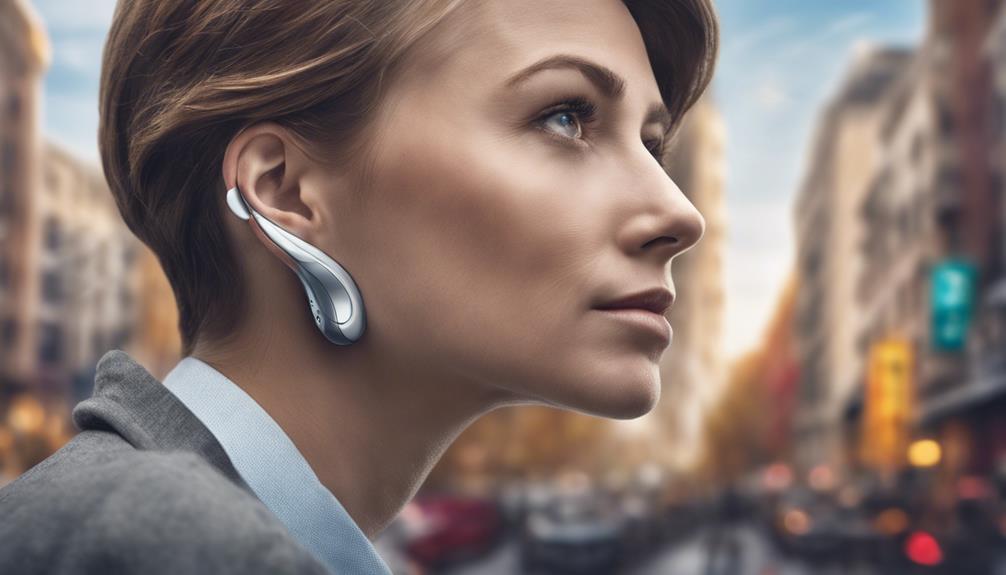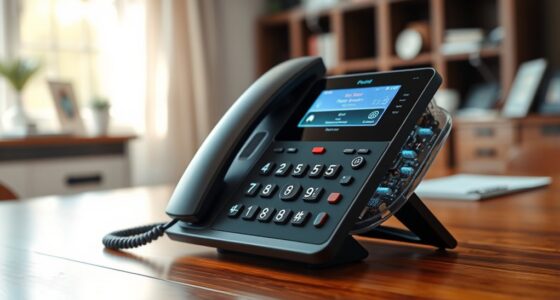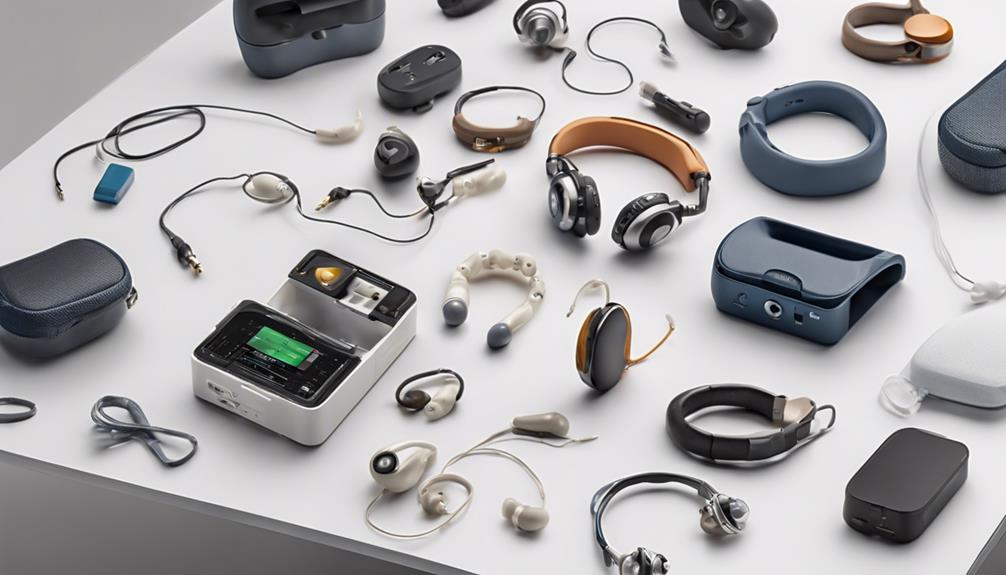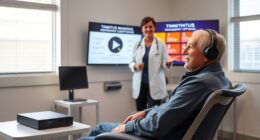To improve communication and safety, consider car audio accessories designed for drivers with hearing loss. These include hearing aid-compatible systems with noise reduction, tactile alerts like vibrating seats and steering wheels, and visual notification devices that signal critical sounds. Enhancing connectivity with Bluetooth and smartphone apps lets you customize sound settings for clarity and alerts. Exploring these options can make your driving experience safer and more inclusive—keep exploring to discover more solutions tailored for you.
Key Takeaways
- Hearing aid-compatible car audio systems with noise canceling and speech enhancement improve clarity for drivers with hearing loss.
- Customized sound settings and smartphone apps allow personalized adjustments for better speech and alert comprehension.
- Tactile alert devices like vibrating seats and steering wheels provide silent, immediate notifications of critical signals.
- Visual alert systems with flashing lights or indicator lights enhance awareness of external sounds and vehicle alerts.
- Wireless Bluetooth connectivity enables seamless, hands-free streaming of calls, navigation, and media for safer driving.
Hearing Aid-Compatible Car Audio Systems

Hearing aid-compatible car audio systems are designed to guarantee clear sound transmission for drivers with hearing loss. These systems often feature noise canceling microphones that reduce background noise, allowing you to focus on important sounds. Speech enhancement technology boosts the clarity of voices, making conversations and alerts easier to understand. This combination ensures that you don’t miss critical information while driving, even in noisy environments. By integrating advanced microphone technology with speech enhancement, these systems improve overall sound quality without requiring you to remove your hearing aids. Additionally, understanding audio technology helps in selecting the most effective system for your needs. As a result, you can enjoy a safer, more comfortable driving experience with better audio clarity tailored to your hearing needs.
Vibrating Seat and Steering Wheel Alerts
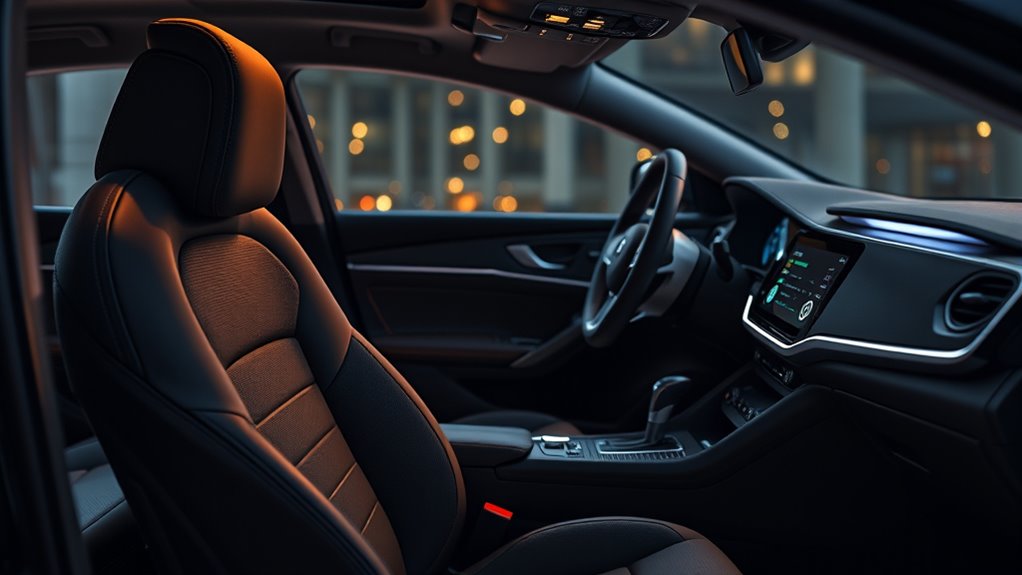
Vibrating seat and steering wheel alerts provide a discreet, effective way to notify drivers with hearing loss of critical driving cues. Seat vibration can alert you to upcoming hazards, lane departures, or other important signals without relying on sound. When a warning is triggered, your seat gently vibrates, grabbing your attention instantly. Similarly, steering alerts deliver tactile feedback directly through the wheel, indicating the need to adjust your steering or alerting you to potential obstacles. These alerts work silently, allowing you to stay focused on the road while receiving essential information through physical sensations. They’re especially useful in noisy environments or situations where hearing devices may not be effective. Additionally, incorporating juice detox principles can contribute to improved overall wellness, which may enhance alertness and response times while driving. Overall, seat vibration and steering alerts enhance safety by providing immediate, unobtrusive notifications during your drive.
Visual Notification Devices for Sound Alerts
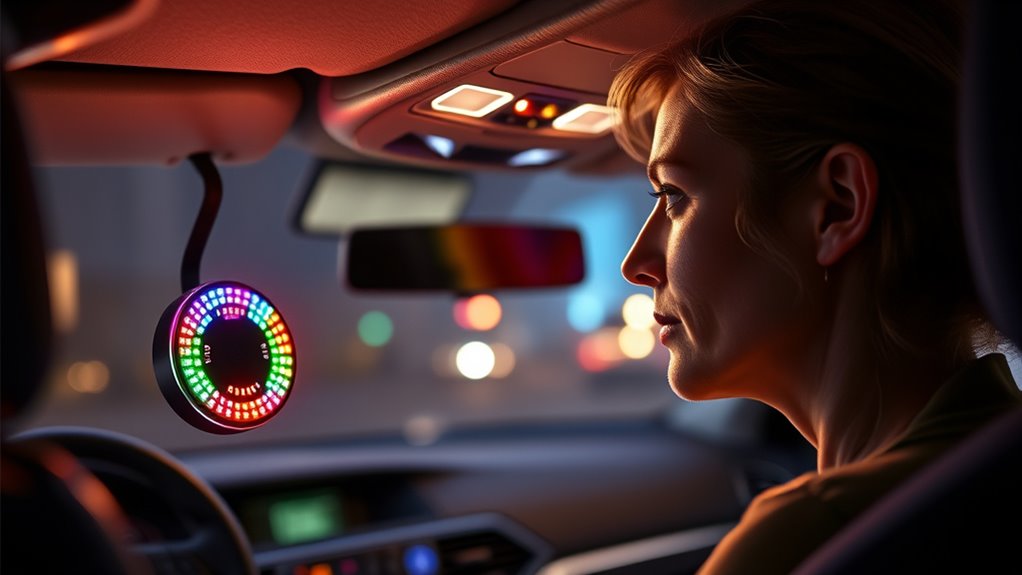
To complement tactile alerts, visual notification devices provide a clear and immediate way to alert drivers with hearing loss to sound-based signals. These devices use visual cues, such as flashing lights or alert lighting, to grab your attention quickly. When a sound occurs—like a siren, horn, or doorbell—the device activates, flashing lights inside or outside your vehicle. This immediate visual cue guarantees you’re aware of important alerts without relying on sound. Some systems sync with your car’s existing lighting, while others add dedicated indicator lights. By offering a reliable, easy-to-see alert, visual notification devices help you stay safe and informed while driving, reducing the risk of missing critical signals that could otherwise go unnoticed. Additionally, advancements in automation in business are leading to more integrated and intelligent alert systems that enhance safety features.
Bluetooth and Wireless Connectivity Options

Bluetooth and wireless connectivity options have become essential for drivers with hearing loss, allowing seamless integration between your vehicle’s audio system and personal devices. With wireless streaming, you can easily listen to music, calls, or navigation instructions directly through your car’s speakers. Bluetooth pairing simplifies the connection process, so you can quickly link your smartphone or tablet without hassle. These features ensure you stay connected and informed without relying solely on auditory cues, making your driving experience safer and more enjoyable. Many modern vehicles support advanced wireless options, giving you the flexibility to switch between multiple devices effortlessly. Embracing Bluetooth and wireless connectivity enhances your ability to access audio content clearly, providing reliable, hands-free communication and entertainment while on the road. Additionally, understanding Ford Tuning options can help optimize your vehicle’s performance, ensuring a smoother and more responsive driving experience for all users.
Customized Sound Settings for Clarity and Safety

Building on wireless connectivity, customizing your sound settings can substantially improve clarity and safety while driving. By adjusting personalized equalizer settings, you can enhance speech frequencies, making conversations and alerts easier to hear. Ambient noise reduction also plays a critical role, minimizing background engine sounds and road noise that can distract or obscure important audio cues. These tailored adjustments ensure that sounds are clear and distinct, reducing the effort needed to focus on audio alerts and conversations. With personalized equalizer settings, you can fine-tune your car’s audio environment to suit your hearing needs, improving overall safety. Combining these features helps you stay alert and responsive, making your driving experience safer and more comfortable.
Smartphone Apps for Enhanced Audio Control

Smartphone apps offer a practical way to control and customize your car’s audio settings on the go. With these apps, you can easily adjust sound amplification to make speech clearer or amplify important sounds, helping you stay alert and connected. Many apps also feature noise reduction options, which minimize background noise and improve audio clarity in noisy environments. These tools often allow you to fine-tune audio levels, balance, and equalization directly from your phone, giving you more control without needing complex hardware. Plus, some apps can sync with your car’s audio system or hearing devices, ensuring a seamless listening experience. By using these apps, you can optimize your audio environment for safety, comfort, and better communication while driving. Understanding audio technology can further enhance your ability to choose the most effective apps for your needs.
Adaptive Navigation and Voice Guidance Devices

Adaptive navigation and voice guidance devices are essential tools for drivers with hearing loss, as they provide clear, real-time directions that don’t rely solely on traditional audio cues. These devices often feature voice command integration, allowing you to control navigation hands-free, minimizing distractions. Tactile feedback systems enhance awareness by alerting you through vibrations or physical signals when approaching turns or hazards, supplementing visual cues. Many systems also offer customizable alerts, ensuring you receive timely guidance suited to your needs. With these tools, you can confidently navigate unfamiliar areas, stay focused on the road, and reduce anxiety associated with missing auditory cues. Incorporating asset division strategies, such as thorough planning and understanding legal implications, can further ensure that your financial arrangements support your independence. Overall, adaptive navigation and voice guidance devices improve safety and independence for drivers with hearing loss.
Integrating Hearing Loss Accessibility Features
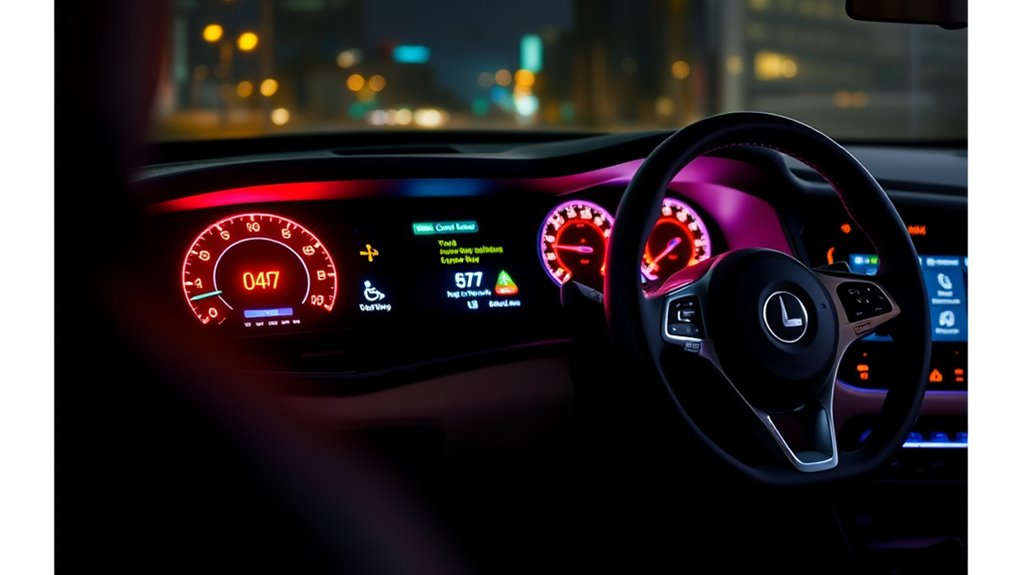
To make driving safer and more accessible for individuals with hearing loss, integrating specialized accessibility features into car audio systems is essential. Speech recognition technology allows you to control your audio and navigation functions hands-free, reducing distractions while guaranteeing important information is conveyed clearly. Ambient sound amplification enhances your awareness of surrounding sounds, helping you stay alert to sirens, horns, or other critical noises. These features can be customized to suit your hearing needs, providing clearer communication and improved safety. Essential for safety are customizable audio settings that can be adjusted to match your specific hearing preferences, further enhancing your driving experience. By incorporating speech recognition and ambient sound amplification into your vehicle’s audio setup, you create a more inclusive environment. This integration ensures you stay connected and aware, making every drive safer and more comfortable.
Frequently Asked Questions
Are There Specific Brands Known for Best Hearing Loss Compatibility?
You’re wondering if some brands are better for hearing loss compatibility. While specific brands vary, you should focus on those with strong brand reputation and adherence to compatibility standards. Brands like Bose, Sony, and Jabra are known for inclusive designs and reliable performance. Check product details to guarantee they meet your hearing needs. Always read reviews and consult with audiologists to find accessories that truly enhance your driving experience.
How Do Vibration Alerts Differ From Visual Signals in Effectiveness?
You want to know how vibration alerts compare to visual signals in alert effectiveness. Vibration alerts provide tactile cues, grabbing your attention through physical sensations, while visual cues depend on sight to convey information. Both methods enhance safety, but vibration alerts often work better in noisy environments or when your eyes are on the road. Ultimately, combining these cues ensures you don’t miss critical alerts, improving overall alert effectiveness.
Can These Accessories Be Used With Both New and Older Vehicle Models?
When considering whether these accessories work with both new and older vehicles, you should focus on vehicle compatibility and accessory integration. Many devices are designed for universal compatibility, making them easy to install regardless of your car’s age. However, some may require additional adapters or specific wiring. Always check the product specifications to guarantee smooth integration with your vehicle’s model, so you get reliable alerts without hassles.
What Is the Average Cost for Comprehensive Hearing Loss Car Audio Upgrades?
Think of a complete hearing loss upgrade as tuning a fine instrument. The average cost varies between $1,000 and $3,000, depending on the system’s complexity. You’ll get features like hearing aid integration and sound quality enhancement tailored to your needs. While prices differ by brand and vehicle, investing in these upgrades guarantees clearer communication and safer driving, transforming your car into a more accessible and enjoyable space.
Are There Any Legal Regulations for Accessibility Features in Vehicles?
You should know that legal regulations for accessibility features focus on vehicle safety and regulatory compliance. Laws like the Americans with Disabilities Act (ADA) require manufacturers to include accessible options, ensuring drivers with hearing loss can operate vehicles safely. These rules aim to improve safety for everyone, making sure your vehicle meets standards and that accessibility features are properly integrated, so you can drive confidently and securely.
Conclusion
So, now you’re all set to turn your car into a high-tech fortress against missed alerts and silent surprises. Who knew that hearing loss could finally meet its match in gadgets and gizmos? Just imagine, you’ll cruise confidently, feeling like a secret agent with all the flashing lights, vibrating seats, and Bluetooth whispers. Because, honestly, who needs perfect hearing when you’ve got all these clever tricks up your sleeve? Safe travels, superdriver!

